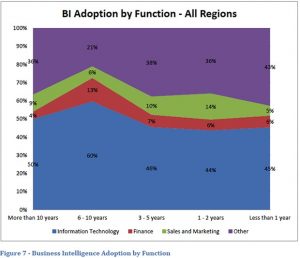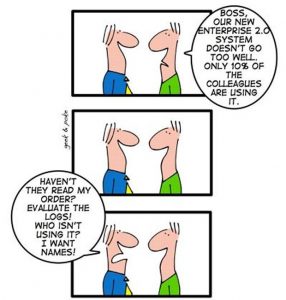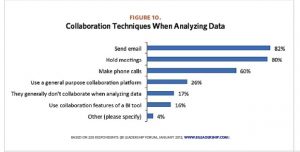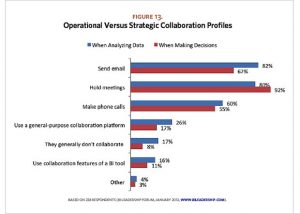Business Intelligence
Consumerization of BI: Handing the Tool Right to the User
Tradition can be a good thing. It can bring people together, maintain the bonds of friendship and culture, and ensure the continuation of positive or charitable actions.
Tradition can also be bad; often used as a poor excuse for the continuation of outdated, ineffective or inefficient practices. Now, this doesn’t mean that traditional practices, struggling to keep pace with modern demands, must be discarded. Sometimes, they just need to be supplemented with new ideas and best practices that reflect contemporary expectations.
Mark Smith – CEO and Chief Research Officer of advisory and analyst firm Ventana Research – made a call for strong change in his now infamous dissertation on The Pathetic State of Dashboards. Smith argued that current Business Intelligence (BI) dashboards had remained largely unchanged since their emergence as a primary method for displaying BI content in the 1980s.
“The early forms of dashboards appeared in the 1980s, but in my honest evaluation, today’s dashboards have not gotten much more intelligent in all those years,” wrote Smith.
It’s difficult to argue with Smith’s contention. For the most part, the way dashboards – the status quo for visualizing analytical information – communicate and display information has remained largely unchanged, failing to adapt to the shifting user base for reporting and analytics. This of course, is a big problem.
REGISTER NOW >
BI is swiftly busting its way out of the traditional confines of the IT department. Not that long ago, BI was the exclusive domain of propeller heads – the hardcore IT specialist or analyst.
Changes in BI Governance and Usership
We know that business users are having a greater say when purchasing a BI solution. But how are usership figures changing in accordance? As evidence that BI is becoming more pervasive and end-user oriented, Gartner’s latest BI Magic Quadrant survey demonstrated that an increasing percentage of business (non IT) people were utilizing BI software. Of the 1,364 respondents to Gartner’s 2012 BI Magic Quadrant survey, only 38.9 percent identified themselves as pure “IT”, with 20.8 percent listing themselves as a “business user”, while 40.3 percent said they had “blended business and IT responsibilities”.
While, due to BI’s inherent complications, the IT department still represents the single largest group of functional users, its majority has been eroded. Dresner Advisory Services’ (DAS) 2012 Wisdom of Crowds Business Intelligence Market Study found that around 45 percent of global BI deployments were aligned with the IT department.

The other 55 percent was split between various business functions, predominantly the finance, sales and marketing departments. However, the study found a further broadening of BI users, stating that “Increasingly, functions other than Finance and Sales and Marketing have grown in their adoption of Business Intelligence. For the past three years we have observed a shift away from IT alignment (and deployment) of Business Intelligence, in favor of line-of-business management and users. In this year’s study, we see this trend continuing, with IT-aligned deployments holding steady at 45 percent, and deployments which are more aligned with business users, at ~ 54 percent world-wide.”
So what’s responsible for this trend? Simply put, organizations are realizing the potential benefits of fact-based decision-making across an expanding number of organizational roles. They’re also grasping the concept that if more people have the ability to harness pertinent, up-to-date and timely fact-based information, the better relative Return on Investment (ROI) they can garner from reporting and analytics.
In fact, industry analyst Cindi Howson recently remarked that “to be successful with BI, you need to be thinking about deploying it to 100 percent of your employees as well as beyond organizational boundaries to customers and suppliers”.
Given the shifting demography and skillsets of BI users, there are significant implications for BI technology. Essentially, vendors can’t assume an analytics background anymore.
The BI community needs to rethink how BI content is communicated to an ever-widening array of user types, to empower them to accurately interpret, share and act on BI content. After all, there’s no ROI for BI unless better decisions and actions are taken as a result of the insight produced.
The Consumerization of BI Drives Greater Adoption and BI ROI
The continued consumerization of BI – the inclusion and development of user-friendly features and functionality making reporting and analytics accessible to a greater diversity of users – has played a role in generating more widespread user adoption. Gartner’s June 2011 report – The Consumerization of BI Drives Greater Adoption – stated that the consumerization of BI had resulted in a new bread of end-user focused BI solutions, capable of delivering faster, more relevant results to business people of all backgrounds, and a better ROI. The report also suggested that the trend marked “arguably the biggest shift in BI adoption since the rise of enterprise-class BI platforms in the late 1990s.”
Studies from the TDWI and BeyeNetwork have also demonstrated the link between pervasive BI and superior ROI for BI initiatives. The TDWI research report – How Pervasive BI is Good for Your Business and How to Get There – found the number of active users is one of the best performance indicators for any BI implementation. The study concluded that BI adoption and usage rates remain low because most BI products are still geared towards analysts and power users. The BeyeNetwork’s research report, Ease of Use and Interface Appeal in Business Intelligence Tools, also directly linked BI adoption to ease-of-use and BI ROI.
But Is The Consumerzation of BI Enough?
But is the cosumerization of BI enough, on its own, to bridge the gap between BI technology and business users? It’s doubtful.
Even the most optimistic reports by TDWI and BIScorecard suggest most BI deployments sit at a sobering adoption rate of 24 or 25 percent respectively – an entire solar system away from Howson’s heady call for deployment to 100 percent of employees.
Further, Gartner has previously stated that 80 percent of BI projects fail, citing poor communication and collaboration as the primary reasons.

The failure rates of BI implementations, and persistently low user adoption rates, are indeed reflective of our inability to re-imagine the way in which we communicate the key messages represented by data. According to Information Masters, 75 percent of BI success is determined by factors other than data and core analytical technology – so thinking about HOW data is presented, shared and discussed in order to enable effective decision–making is paramount.
As Smith surmised: “If we expect our organizations to move beyond personal productivity tools and work in a collaborative enterprise environment… we better understand how business intelligence should adapt to the way people work and operate; not the other way around.”
Collaborative BI Has The Potential To Support Natural Decision-Making Processes
Collaborative BI – the integration of information sharing features and functionality of popular Web 2.0 technologies and social media platforms within a BI platform – has the ability to form crucial connections between people, process, data and technology, to bridge the gap between insight and action by supporting peoples’ natural decision-making processes.
Or, as BI veterans Claudia Imhoff and Collin White define Collaborative BI, and its relationship to more traditional BI software, in their article Collaborative BI Sets Stage for Collective User Action: “BI software enables business users to report on and analyze business processes and associated activities, while collaboration tools enable the results of BI queries and reports as well as other related information to be accessed and shared by multiple users.
“The ultimate goal of any BI environment is to make timely and better business decisions. A collaborative BI environment supports team efforts to assess situations and make decisions.”
Gartner predicts that by 2013, 15 percent of BI deployments will combine traditional BI and collaboration components in a singular decision-making environment. I believe this figure is extremely conservative. Or if it’s accurate, far too many vendors are hopelessly behind the fast disappearing ‘ball’.
This demand for better enterprise collaboration and collective decision-making capabilities is part of a wider spike in demand for CDM software, with analyst firm IDC reporting a 5.1 percent uptick in CDM software sales for the first half of this year – the fastest growing global software segment.
Wayne Eckerson’s Collaborative Business Intelligence: Optimizing the Process of Making Decisions report found that 87 percent of BI professionals believe that “collaboration tools can have a positive impact on analysis and decision-making activities”, while “Fifty-eight percent of BI professionals plan to evaluate collaboration features when they purchase their next BI tools” – up from a lowly 16 percent who evaluated collaborative capabilities as part of the selection process for their current BI solution.
SnapLogic’s 2011 Application Connection Priorities report also found significant support for the combination of CDM modules and BI. Based on a study of over 100 IT executives, the report found that BI (39 percent) and collaboration (36 percent) applications were the two highest priority applications to connect to during 2012.
And given early research into this emerging area, it’s no wonder that organizations are keen to embrace the concept. A study conducted by the Aberdeen Group found that those organizations that embraced and implemented best practice Collaborative BI enjoyed a 42 percent improvement in employee productivity, a 30 percent increase in business process efficiency, and a 40 percent rise in BI adoption.
So the demand is there; and even the results for a select few top-performing organizations. But what constitutes Collaborative BI? Eckerson’s study lists the top collaboration features demanded by BI professionals as annotations (67 percent), threaded discussions (62 percent) and shared workspaces (60 percent). These are all useful – a good start. But how can we integrate that technology into our natural decision-making protocols, such as meetings? How can we actually transform the hope invested in collaborative decision-making technologies into better business outcomes?
Current Collaborative BI misses the mark
Eckerson proposes that “understanding how users collaborate helps organizations select the correct collaboration features and tools to implement.” This makes a lot of sense. But, wouldn’t it also be equally fair to say that understanding how users collaborate, when it comes to making decisions and taking action based on BI content, helps BI vendors develop the correct collaboration features and tools? Unfortunately, most vendors seem to be missing the mark – or at least a link.
Consequently, “we still see a real gap between the level of information in BI and the quality and transparency of decision-making,” said Gartner’s Rita Sallam in a recent interview.
According to Eckerson’s study, of those using BI solutions that already contain collaborative features, only 16 percent use them. So why are users snubbing the collaborative elements currently available, when there’s such an obviously strong demand for features that can assist collaborative decision-making within a BI environment?
Again, it seems that most vendors aren’t listening to their customers, or heeding the advice of Smith – that we need to be assisting BI users to collaborate around BI content and make decisions from that learning in natural ways, rather than forcing them to interact in an unnatural way.
“If we want to learn from the disappointing decades of business intelligence deployments, then we should find out what our business users really need to take action and make decisions on the information,” wrote Smith.
As Imhoff and White pointed out in a recent blog post relating to their work in the Collaborative BI realm: “A collaborative BI environment that is designed for the wrong types of users will not be used and will not provide a good return on investment.”
So what are the top ways in which people like to collaborate when analyzing data? Emails (82 percent) and meetings (80 percent) are the two standout frontrunners according to survey respondents to Eckerson’s recent Collaborative BI study.

Now, what happens when people are making decisions based on the insights gleaned from that data analysis? This is where it gets interesting. The previous favorite technique, sending emails, drops from 82 to 67 percent – still the second most preferred method for data-based decision-making. Conversely, meetings – a close second choice method for analyzing data – jumps to an obvious and outright first choice method for data-based decision-making (92 percent).

People like to make crucial decisions together; face-to-face. Why would it be any different when acting on the information produced by BI? Decision-making – especially when making important ones – is an inherently collaborative process. Any sales executive worth their salt will tell you that a face-to-face meeting is the best way to get a client onboard, or secure commitment to a course of action.
Implications For The Future Direction of Collaborative BI and BI ROI
It seems that blending BI and collaborative capabilities with a comprehensive presentation platform would enable users to integrate fully interactive data-rich presentations into their natural decision-making processes (meetings), to generate an analytics culture, realize BI ROI and drive real fact-based action.
Or, as Imhoff and White put it: “Organizations can implement collaborative interaction and information enhancement features using the capabilities currently offered by, or being added to, BI tools. Supporting collaborative decision-making, however, requires the use of a collaborative platform or a separate system designed specifically to meet the need for collaboration in the decision-making process.”
We don’t want to give too much away, but – and while shameless plugs aren’t our normal modus operandi – we think we may have found the answer, and transformed BI’s information paradigm in the process.
In the words of eclectic singer-songwriter Bob Dylan: I feel a change comin’…
Looking for more information on business intelligence? Our exclusive Top 10 BI Software report compares 10 of the top analytics tools on the market in key features, pricing, technology model and more.






